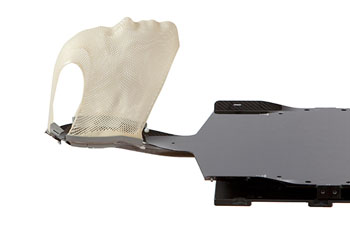Nano-Based Masks Increase Radiation Therapy Comfort
By MedImaging International staff writers
Posted on 28 Oct 2016
New immobilization masks made from nano-enhanced thermoplastic sheets reduce pressure on the face during radiation therapy (RT).Posted on 28 Oct 2016
The Orfit (Wijnegem, Belgium) hybrid head masks are made by interweaving natural nano-clay into the inner layers of a proprietary thermoplastic material called Nanor to provide improved mechanical properties and thinner masks with less shrinkage, since the thermoplastic masks shrink when they cool on the patient during positioning. This provides enhanced patient comfort, in particular since the patient tends to swell during the course of RT. The reduction of shrinkage provides the degree of comfort required to minimize patient movement during the delivery of the radiation dose.

Image: A Nanor hybrid head mask and HP Pro Solution baseplate (Photo courtesy of Orfit).
Laboratory tests have shown a reduction of fixation force when using the hybrid immobilization head masks, making patient immobilization easier and contributing to patient comfort, and ultimately to the effectiveness of RT. The tests also revealed that the reinforced Nanor thermoplastics have a higher bending modulus, allowing for a reduction of the thickness of the immobilization masks to 1.2 and 1.6 mm instead of 2 and 3.2mm of regular masks, while maintaining identical mechanical properties.
Orfit also supplies the HP PRO Solution, an immobilization device designed for brain and head and neck treatments in both photon and proton therapy, which makes use of ultra-thin Nanor masks. The solution includes a homogeneous low-density immobilization board with a narrow carbon fiber base plate in the head and neck area, allowing for closer range positioning of the RT device. The lightweight base plate also has good dosimetric properties. The Nanor masks are affixed with a patented mechanism that locks the mask profile onto the base plate.
"Ensuring patient comfort has always been and continues to be one of our major priorities. We firmly believe that theOrfit HP Pro Solution, used in combination with our nanotechnology-based masks, will help alleviate discomfort and anxiety, which is especially important when treating children,” said Steven Cuypers, CEO of Orfit.
Reproducible positioning of the patient over multiple rounds of RT demands reliable immobilization for an accurate and consistent treatment setup. The use of low-temperature thermoplastic materials molded over the patient’s head effectively immobilizes movement, reducing the amount of time that it may take to receive RT and minimizing unwanted side effects such as damage to the skin, the upper digestive tract, and rampant caries due to damage to saliva glands.
Related Links:
Orfit














